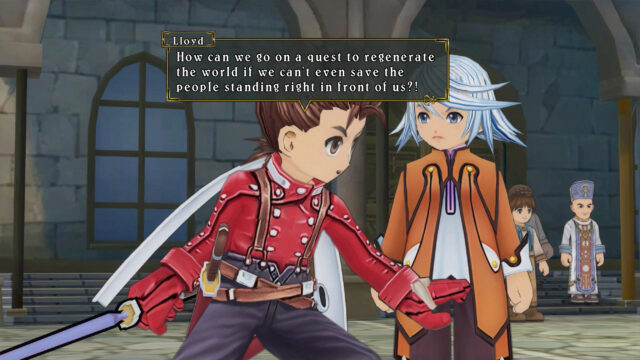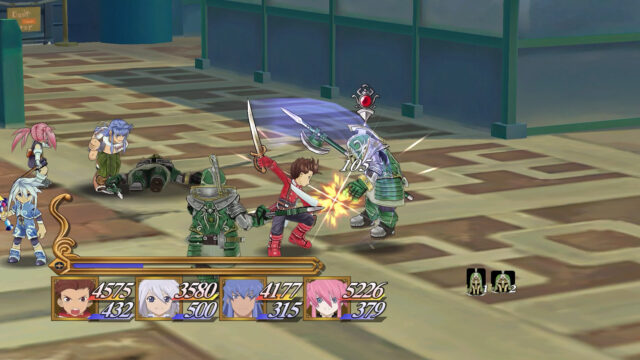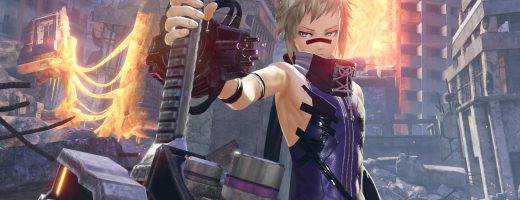Tales of Symphonia as a JRPG Gateway
This week’s release of Tales of Symphonia Remastered sees the game becoming the latest classic JRPG to get the treatment and both introduce it to a new generation of potential fans as well as give veterans the opportunity to rekindle past love. While another member of our review team will provide their in-depth thoughts on the game soon, I wanted to take the opportunity to indulge in some shameless nostalgia, particularly how the game acted as my real gateway into JRPGs.
I had played multiple RPGs prior to Tales of Symphonia; most notably Pokémon and Golden Sun, plus watching a friend play through Final Fantasy IX. However, it was with a mixture of Tales of Symphonia that I garnered a proper interest in exploring like-minded games and noting RPGs as a genre of particular interest. My decision to pick up Tales of Symphonia comes at a time when thanks to another friend I had started developing an interest in anime, and the obvious parallels with its box art is what first grabbed my attention. But from the moment I put the first disc into my GameCube, I was hooked.
Tales of Symphonia’s narrative has definitely been formative of my RPG tastes, and it’s still right up there for me as RPG stories go. As a relative newcomer to the genre, I perhaps wasn’t able to appreciate the full extent to which it subverts player expectations, but even then the way it goes about presenting its tale is enrapturing. It is quite happy to dive into some storytelling tropes, such as the home village destruction leading to main protagonist Lloyd setting out on his adventure. Some events are certainly cheesy, such as the hot and cold coffee scene and almost every time the dwarven vows are brought up, but the game packs them full of such earnestness that I was more than happy to just be swept along for the ride.
What starts out seeming like a traditional adventure to save the world from evil overlords soon becomes something much different, and even knowing what’s coming on a replay it never disappoints in how many unexpected turns it takes. There are many different themes that get solid examinations, with self-sacrifice, revenge, justice, and racism being among the key elements explored. It can be a bit blunt with its messaging, but it goes out of its way to look at things from multiple angles. The fact that it is confident in its messaging, and that the messaging is always geared towards enacting positive change makes it understandable that sometimes it determines things just need to be come out and be said.
While he starts off hot-headed, Lloyd Irving becomes one of the more memorable idealist heroes by the end as he strengthens that resolve through witnessing numerous tragic events throughout the game, moving away from his desire for justice. It has memorable characters across the board, from the playable party through its antagonists and supporting cast. Each of the party has their own flaws or trauma they need to overcome, and are all endearing in their own way, though Sheena is definitely the best. The narrative and cast are huge parts of what made me a fan of this game and RPGs in general.

Tales of Symphonia’s narrative does a fantastic job of playing on expectations, and treating its subject matter from multiple angles.
Tales of Symphonia was the first title in the series to use full 3D graphics, but it made great use of the anime aesthetic on its character models and environments. The game looked great, especially on the GameCube where it ran at 60fps, and the style ensures that it holds up well today. There are definitely areas where a modern eye will see the weaknesses of it, especially in its more action-oriented story events. Aiding the narrative presentation is a strong voice cast that does feel like it fully plays into the anime aesthetic, with many names that will still be familiar. Motoi Sakuraba and Shinji Tamura’s score is also a fine introduction to the genre; it definitely has Sakuraba’s style so those who have heard his work elsewhere won’t be too surprise, but it has many catchy riffs that keep players drawn in.
Although its gameplay has been significantly improved upon across the series later entries, many of the Tales gameplay staples get their introduction here, making this a great entry point for those interested in getting into the series now, let alone back when I got bitten by the RPG bug. Combat is a highly entertaining combo-driven driven system with a hybrid of 2D and 3D, though the lack of full free movement may be a bit restrictive for newcomers coming in now. It’s still a highly enjoyable system with plenty of back-and-forth and players look for openings while avoiding or defending attacks. It has the added bonus of having multiplayer in combat, as well as letting players choose which character to control, each with their own distinct styles, opening it up for some fun experimentation, though I must admit to being a bit boring and generally sticking with Lloyd for my past playthroughs.

While subsequent series entries have significantly improved on the combat, it’s a great example of being intuitive to pick up and staying exciting throughout.
One thing Tales of Symphonia has that I’m sad has been dropped from the series for some time, and is a rare sight in the genre in general nowadays, is its spatial puzzles. As someone with a more logical brain, I was very happy to be able to put it use in the game’s dungeons, nearly all of which had some puzzle elements to them, such as pushing blocks, sliding movement, or manipulating lightning. There’s a strong amount of variety to them and along with the visual designs they help make each dungeon distinct. I’ve definitely come to notice that a number of my formative RPGs performed strongly in this area without the puzzles themselves being the be-all and end-all. They add to each dungeon’s experience, and Tales of Symphonia remains one of my favourite examples of utilising puzzles in the genre.
With so many new RPGs always ready to try and grab attention, it’s tough to find time to come back and replay a game. Tales of Symphonia is one I’m absolutely willing to find the time to get to and relive the game that properly made me an RPG fan. Even if the gameplay won’t be as flashy as its more recent entries, the earnest story packed full of interesting turns is one I still adore and am looking forward to working through again.







Recent Comments